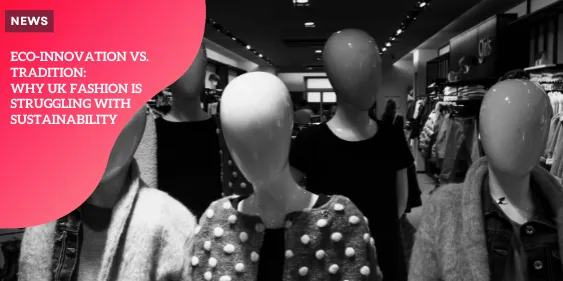Eco-Innovation vs. Tradition: Why UK Fashion is Struggling with Sustainability

Alarming Statistics and Comparisons
British fashion is alarmingly behind in its sustainability efforts.
Shockingly, only 3.4% of British Fashion Council (BFC) members have emission reduction targets aligned with the Paris Agreement.
This is in stark contrast to 44% of all UK companies, which have structured carbon reduction plans.
That’s not just a gap; it’s a chasm.
Fast Fashion and Luxury Both Contribute
Whether it’s fast fashion or luxury brands, both segments contribute significantly to environmental damage.
These brands seem to prioritize profit over environmental responsibility, creating a major roadblock to sustainable practices.
But why is that?
Profit Over Planet
There’s a persistent focus on profit and an aversion to adopting new, eco-friendly materials.
Brands are sticking to what they know, avoiding the financial risks associated with switching to sustainable alternatives.
A Call for Change
It’s evident that a major shift is required.
From tax incentives for eco-friendly brands to stricter sustainability standards at fashion events, multiple strategies can help drive this change.
Government intervention is crucial to make these initiatives more effective.
Without a doubt, the state of sustainability in British fashion is dire and demands urgent action.
This issue is not just about the brands but also about systemic change, which we’ll explore next in the upcoming sections.
Barriers to Sustainable Practices
Prioritization of Profit Over Climate Action
The British fashion industry is facing significant scrutiny for placing profit above climate action.
This focus on financial gain is a major hindrance to adopting sustainable practices.
Despite the well-documented environmental impact of the fashion sector, many brands continue to operate under a “business-as-usual” mindset, which stalls necessary reforms.
The minimal number of British Fashion Council members adhering to Paris Agreement emission targets underscores the lack of commitment within the industry.
Reluctance to Adopt New Eco-Friendly Materials
Another critical barrier is the industry’s hesitation to embrace new, eco-friendly materials. Innovations like plant-based leather have emerged as promising alternatives to traditional, carbon-intensive materials.
However, their adoption remains sluggish. This reluctance stems from a fear of the unknown and an attachment to conventional materials and methods.
This pervasive resistance is detrimental, as the production of fossil fuel-based and animal-derived materials accounts for a staggering 38% of the industry’s total emissions.
Lack of Incentives for Tackling the Climate Crisis
Adding to the challenges is the paucity of incentives for brands to tackle the climate crisis head-on.
Currently, there are minimal rewards or penalties driving companies to adopt greener practices.
Experts argue that tax incentives for climate-conscious brands could motivate significant change.
Stricter sustainability standards, such as those enforced by Copenhagen Fashion Week, could also push the industry towards more eco-friendly practices.
The inertia within the British fashion industry necessitates innovative solutions and a concerted effort from both the government and consumers to foster a more sustainable future.
Making conscious changes today can pave the way for a more environmentally responsible industry tomorrow.
The Impact of Traditional Materials
Material Production and Emissions
Material production in the British fashion industry is a significant contributor to environmental degradation, accounting for 38% of the industry’s total emissions.
Traditional materials such as virgin leather, wool, and synthetic fabrics derived from fossil fuels dominate the landscape, propelling these figures.
Addressing Fossil Fuel-Based and Animal-Derived Materials
The fashion world urgently needs to tackle the use of both fossil fuel-based and animal-derived materials.
Alternatives exist, yet the industry remains anchored in long-established practices, largely due to misinformation and a lack of robust incentives to shift.
For instance, methane-intensive materials like leather, wool, and cashmere come with substantial greenhouse gas emissions that are often underestimated.
Misconceptions and the Path Forward
Misunderstandings about the environmental impact of animal-derived materials persist.
The association of luxury and quality with these materials clouds the reality of their environmental cost.
Yet, innovative solutions offer promise.
Brands like Ganni have shown success in reducing emissions by eliminating virgin leather from their collections, underscoring the potential of next-gen bio materials like plant-based leathers.
To mitigate the impact of traditional materials, brands must embrace creative and sustainable fabrications.
By reevaluating historical norms and adopting forward-thinking material choices, the industry can make substantial strides in reducing its carbon footprint and environmental impact.
Innovative Solutions and Success Stories
Next-Gen Bio Materials
The fashion industry’s wasteful practices have prompted a wave of innovation, particularly in the realm of next-gen bio materials.
Plant-based leather alternatives, derived from sources like cactus, mushrooms, and pineapple leaves, offer a promising way to reduce the industry’s carbon footprint.
These materials not only minimize reliance on harmful fossil fuel-based products but also sidestep the significant environmental impact associated with animal-derived materials, such as leather.
Ganni’s Success
A shining example of embracing eco-friendly materials in fashion is the Danish brand, Ganni.
By deciding to phase out virgin leather and adopt recycled and alternative options, Ganni significantly reduced its carbon emissions.
This decision has demonstrated that it is not only possible but also beneficial for brands to shift towards sustainable materials.
Ganni’s success story proves that sustainable practices can be incorporated without compromising brand identity or product quality.
Need for Creativity and Innovation
The fashion industry sorely needs more creativity and innovation when it comes to material choices.
While traditional materials like leather and wool are familiar and well-established, they contribute heavily to environmental degradation.
Embracing new materials requires a shift in mindset and a willingness to experiment.
Designers and brands must look beyond the conventional, driving change through innovation and creativity.
Transition smoothly into the next chapter which will discuss proposed strategies for improvement without explicitly mentioning or previewing the next chapter.
Proposed Strategies for Improvement
Tax Incentives for Climate-Conscious Brands
To accelerate sustainable practices in the fashion industry, tax incentives can serve as a powerful motivator.
Brands that achieve substantial emission reductions and adopt eco-friendly materials should be rewarded with tax cuts.
This financial relief could offset the higher initial costs often associated with sustainable practices and innovative materials.
Think of it as a pat on the back—except it’s from the taxman, and it’s more of a hefty tax break.
By making significant reductions in their carbon footprint, these brands not only contribute positively to the environment but can also enjoy an economic boost.
Stricter Sustainability Standards for Fashion Events
Fashion weeks are high-profile events that set trends and influence industry practices.
Implementing stricter sustainability standards at these events can signal a serious commitment to climate action.
Copenhagen Fashion Week leads by example, requiring brands to meet specific sustainability criteria to participate.
Imagine London Fashion Week adopting similar standards—it would be a game-changer.
Such measures can include requirements for using recycled materials, fair labor practices, and transparent supply chains.
These standards can push brands to break away from harmful traditional methods, encouraging creativity and innovation in sustainable fashion.
The Role of Consumer Awareness and Industry Accountability
Grassroots Movements and Individual Actions
The momentum for a more sustainable fashion industry is building from the ground up.
Grassroots movements are crucial in pushing for a cleaner, more accountable industry.
This shift is driven by consumers who are increasingly aware of the environmental impact of their shopping choices.
With platforms like Fashion Revolution promoting transparency and ethical practices, the pressure is mounting on brands to disclose their sustainability efforts.
Necessity for Industry-Wide Changes
While individual actions are commendable, they alone are not enough to drive the sweeping changes required for sustainability.
Industry-wide shifts are essential. Many brands still prioritize profit over environmental responsibility.
This reluctance hampers the adoption of innovative, eco-friendly materials.
Fast fashion and luxury brands alike must commit to meaningful, large-scale changes if the industry is to make significant strides towards sustainability.
Importance of Transparency and Accountability
Transparency in the fashion sector is paramount. Consumers have the right to know the environmental and social footprint of their purchases.
Brands that disclose their sustainability targets and progress foster trust and accountability.
This transparency enables consumers to make informed decisions, further driving the demand for sustainable products.
Accountability is another cornerstone. Without mechanisms to hold companies accountable, real change remains elusive.
Penalties for non-compliance and incentives for meeting climate goals could serve as effective measures.
Tax cuts for brands that achieve their climate targets, as suggested by Aja Barber, offer one potential solution.
Setting sustainability standards for fashion events, akin to those at Copenhagen Fashion Week, could also reinforce accountability.
Transition
In summary, the role of consumer awareness and industry accountability is pivotal in driving sustainable practices in British fashion. However, true progress will require a concerted effort from both consumers and the industry.
The journey for a cleaner, more transparent fashion industry is just beginning, and the next steps will be crucial in shaping its future.






